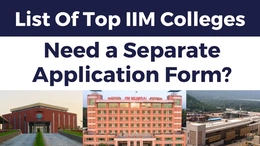How to Choose the Right MBA College After CAT 2024?
After months of hard work and successfully clearing the CAT exam, the next big step in your MBA journey is selecting the right college!
While your CAT performance is crucial, the choice of the right MBA colleges can significantly impact your career. A good MBA program offers not just academic excellence but also access to unparalleled placement opportunities, professional networks, and skill development. Remember, B-Schools are notorious for being extremely demanding - you'll barely eat, you won't sleep but yet you'll love it.
A fairly useful barometer of a B-School is how demanding it is. This however, should not be your criteria. To make life easier, we have given you a range of factors that can help you in deciding on your B-School.
Where an individual may end up by choosing a wrong college would be in a low ROI and little career growth. Thus, it is a very critical decision that must be weighed carefully considering your CAT score, your goals in pursuing a career, and other personal preferences while deciding.
Also Read, CAT Result 2024, Release Date, Download Link @iimcat.ac.in
Factors to Consider When Selecting an MBA College After CAT
- CAT Cutoff: Understand the minimum CAT Cut off by which the college would be accepting. Check in where your score falls, and shortlist the colleges for the same percentile range. "The better the college, the higher its minimum requirement" - is something often believed amongst the students, however, while it may be true for most colleges, we advice students to not apply this everywhere.
- Placement Records: Check for placement reports of the last 3-5 years. It should be showing you average placement package, median salary, and companies that are recruiting from the institute. Do not carried away by high Average CTCs. If you have studied for CAT, you know how averages work. Checking the median salaries as well, a couple of very high CTC outliers can cause a massive change.
- Fees and ROI: Compare the tuition fees with the placement opportunities offered. An affordable fee structure combined with excellent placements ensures high ROI. FMS is an example of an MBA college with an extremely high ROI. While budgetary constrains are extremely important, if you are able to get into a Tier-1 MBA colleges, budget should not be your most important criteria.
- Faculty and Curriculum:A well-rounded curriculum and experienced faculty are crucial to your learning experience. Research the course modules, electives, and specializations offered.
- Alumni Network: An active and extensive alumni network can open doors to job opportunities, mentorship, and professional growth. In fact, if you are confused between two similar colleges, choose the one with a better alumni networks. In times of crisis, it is the alumni network that helps colleges complete their placement targets.
- Accreditations and Rankings: Institutes having accreditations from established bodies, such as AMBA, AACSB, or EQUIS, can provide a good deal of an idea about its credibility. While rankings are also important, they change very frequently. Try looking at 3-5 years of data when you are comparing rankings and do not give unnecessarily high weightages to colleges that have high jumps.
- Specializations Offered: Choose a college that aligns with your career interests. For example, if you are inclined towards finance, then IIM Calcutta is your best option. If you are interested in HR, there is no college better than XLRI.
Best MBA Colleges to Apply After CAT 2024 Results
You probably have your CAT 2024 result in your hand. Given below, we have a table with a list of colleges and details about other criteria that we believe to be the most important. If readers get confused about two very similar colleges, another very important criteria is the number of seats. Ceteris Paribus, choose the college with a fewer number of seats.
| College Name | CAT Percentile Cutoff | Average Fees (INR) | Average Placement Package (INR) |
|---|---|---|---|
| IIM Ahmedabad | 99.5+ | 25 L | 36.14 LPA |
| IIM Bangalore | 99.5+ | 24.5 L | 35.92 LPA |
| IIM Calcutta | 99.7+ | 27 L | 35.07 LPA |
| IIM Lucknow | 99+ | 20.75 L | 30 LPA |
| IIM Kozhikode | 97+ | 22.5 L | 28.05 LPA |
| IIM Indore | 98.5+ | 21.14 L | 25.68 LPA |
| SPJIMR Mumbai | 93+ (profile based) | 22.5 L | 33 LPA |
| FMS Delhi | 99.3+ | 2 L | 34.1 LPA |
| MDI Gurgaon | 96+ HR 98+ BM | 24.99 L | 25.5 LPA |
| XLRI Jamshedpur | XAT : 95+ | 27.4 L | 29.89 LPA |
| IIT Bombay (SJMSOM) | 98+ | 14.77 L | 28.01 LPA |
Also Read, Affordable MBA Colleges In India With Low Fees 2025, Check Now
How to Analyze ROI for MBA Colleges
ROI is considered a very significant selection parameter of an MBA. It calculates your ROI by equating fees with the average salary after you've completed the MBA.
Example:
- If a college charges Rs 20,00,000 as fees and provides the average placement for the Rs 25,00,000 per year, it is a pretty strong ROI.
- On the contrary, if a college takes fees of INR 15,00,000 with an average salary being INR 10,00,000, that doesn't make for an ROI.
While calculating the ROI, keep in mind factors like:
- Fees and Other Charges: Take hostel, books, and more.
- Average and Median Salary: Don't keep all eyes on the maximum package. Median salaries do provide a better picture of it.
- Placement Trends: Understand whether placements are smooth for a couple of years at a stretch.
- Long-term benefits include career growth and better pay raises in the long run as the degree from a prestigious institute will be well-respected.
Also Read, CAT Percentile-wise Colleges in India 2024-25, Check Now
Difference Between IIMs and Non-IIM MBA Colleges
Choosing the right MBA college is an important decision for anyone who is looking forward to building a career in management. The Indian Institutes of Management are widely considered the best for MBA education in India. However, many non-IIM MBA colleges also provide excellent programs. To make it easier for you, we have mentioned few key difference between IIMs and Non-IIM MBA Colleges that will help you compare and choose them
| Aspect | IIMs | Non-IIMs |
|---|---|---|
| Brand Recognition | Known globally for their rigorous curriculum and strong alumni network. | Have strong regional or national reputations but may lack global recognition. |
| Admissions Process | Primarily admit students through CAT, considering academics, work experience, and interviews. | Accept scores from exams like CAT, XAT, CMAT, MAT, or GMAT, with varying selection processes. |
| Fee Structure | Fees typically range from ₹15 to ₹30 lakhs for a two-year program. | Fees vary widely; some top colleges charge fees comparable to IIMs, while others are more affordable. |
| Placement Opportunities | Offer excellent placements with top companies and high salary packages. | Many non-IIMs have strong placement records, though outcomes can vary widely. |
| Faculty and Curriculum | Renowned for experienced faculty and real-world, application-focused learning. | Faculty quality and curriculum differ, but top non-IIMs often match IIM standards. |
How to Research and Compare MBA Colleges After CAT
- Visit Official Websites: First, check the official websites of the institutes shortlisted for program details, placement records, and faculty profiles.
- Read Placement Reports: Analyze placement statistics for at least the last three years. Look for consistency and growth trends.
- Talk to Alumni and Current Students: Reach out to alumni or students on platforms like LinkedIn for insight into the college culture, academics, and placements.
- Attend webinars and admission events: Many colleges have webinars or events organized for aspirants. It will give you a feel of the program and helps in interaction with faculty members.
- Compare fees and placements: Compare fees, average placements, and other facilities by creating a comparison chart.
- Check accreditation and rankings: You may look for NIRF rankings by Business Today or QS World Rankings for global views.
- Visit the Campus (If Possible): If feasible, visit the campus to understand infrastructure, facilities, and student life.
- Assess specializations: The college must have good programs in areas of interest - be it finance, marketing, operations, or HR.


















